Football/Soccer Session (Academy Sessions): Forward Passes Directly from the Defenders to the Forwards

Profile Summary

| Name: | Brian Dene |
|---|---|
| City: | Sydney |
| Country: | Australia |
| Membership: | Adult Member |
| Sport: | Football/Soccer |
Description
Football Problem: Our team cannot find a way to attack through central areas due the opposition having an overload of players in those areas. We need to create passing options, passing combinations and quick ball movement. It also needs to have constant mobility, good positioning and quality technique to achieve success. We practice passing combinations with a focus on direct passes from the defenders to the forwards. (Ball Possession – Middle 3rd)
Attack Principle of Play: Penetration - Destabilise the opponent’s defensive organisation. Width and Length - Use and enlarge the affective playing space of the team. Expand the distances between the opponent’s positions. Make marking difficult for the opponents. Depth Mobility - Create actions to disrupt opponent’s defensive organisation. Create in depth passing options.
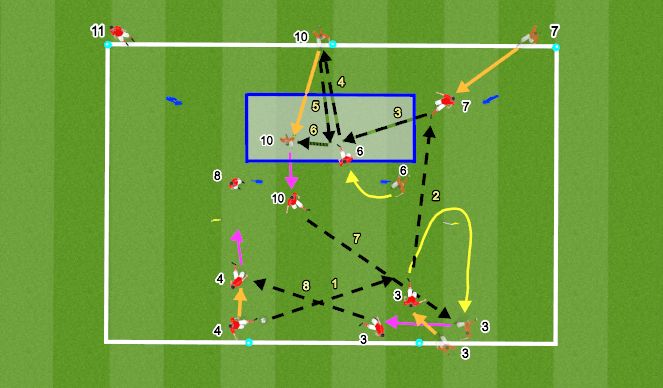
See the guidance at the top of this page to understand why you are not seeing interactive Football/Soccer images.

Passing Practice No.2 (15 mins)
Objective: We practise passing combinations with a focus on direct passes from the defenders to the forwards.
Organisation: Here we have a variation of the previous exercisewe use an area 30 x 30 and have four mannequins, two poles, a marked-outrectangle area and a blue cone.
Set Up: Player no. 4 passes to player no. 3, who receivesthe ball and dribbles forward. As soon as he receives the pass, both player no.7 and player no. 6 move to provide potential passing options. Player no.3 passesforwards to the winger and moves to provide a passing option for a potentialpass back. At the same time, player no. 6 moves forward into the target area, receivesand combines with the player no. 10. The final pass is back to player no.3 whohas run around the pole into his starting position. Player no. 3 receives andpasses towards player no.4 and the exercise starts again towards the left side.
Coaching Points: a. The defenders should move forward quickly with the ball. b. The accuracy, weight and timing of the passes should be monitored. c. Players time their movements to receive and use the correct body shape to provide the appropriate passing options.
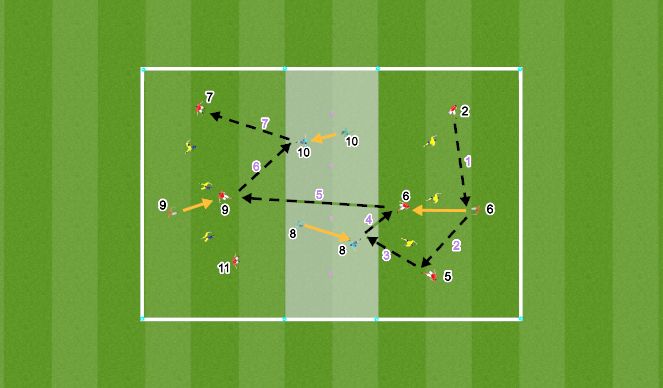
See the guidance at the top of this page to understand why you are not seeing interactive Football/Soccer images.

Positioning Game (15 mins)
Objective: We practise passing combinations with a focus on through the midfield lines.
Organisation: In an area 40 x 45 with two 20 x 20 end zones and a 5 x 20 central zone.
Set Up: Two teams play 3v3 inside both end zones and seek to retain possession and complete at least four consecutive passes with the help of the neutral players who are positioned inside the central area with four mannequins. If they complete four passes, they can then pass the ball to one of their teammates on the other side through the passing lanes between the mannequins. When receiving a pass from the opposite side, a player should use one touch to pass the ball to a neutral player. After this pass, their team will try to complete four passes and then pass back to the opposite side again. The coach passes a new ball in every time the ball goes out of play. The neutrals inside the shaded area are limited to one touch as are the rest of the players when receiving the vertical pass from one area to another.
Coaching Points: a. The focus is on intelligent movement towards the available passing lanes and providing available passing options. b. The quality passes need to be synchronised to the well-timed movements to receive.
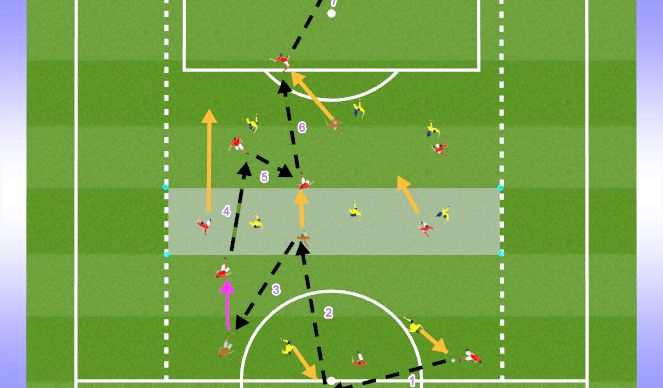
See the guidance at the top of this page to understand why you are not seeing interactive Football/Soccer images.

Game Training (15 mins)
Objective: We practise passing combinations with a focus on direct passes from the defenders to the forwards.
Organisation: In an area 40 x 60 two teams play a 10v9 game. Inside the high zone there is a 3v3 situation, inside the middle zone there is a 3v3 situation and inside the low zone there is a 3v2 situation. The red team's defenders aim to pass the ball to the forwards inside the high zone with the help of the three midfielders (skipping the middle one).
Set Up: The red midfielders inside the shaded area seek to receive the passes back from the forwards and then with the help of their teammates try to score a goal. The red players inside the shaded area act as neutrals and help the defenders retain possession but they are not allowed to pass the ball directly to the forwards. The three yellow players inside the middle area try to intercept the passes. As soon as the pass towards the forwards has been made, there are no restrictions in regard to the zones and the players move freely. If the yellow players win the ball while defending, there are no restrictions for them either as they launch a counterattack and tried to score. During the first stage the red players in the shaded zone are limited to one touch, while the red players inside the low zone play freely.But forwards are limited to one touch when receiving the vertical pass.
Coaching Points: a. The focus is on intelligent movement towards the available passing lanes. b. The players provide available passing options with intelligent synchronised movements.
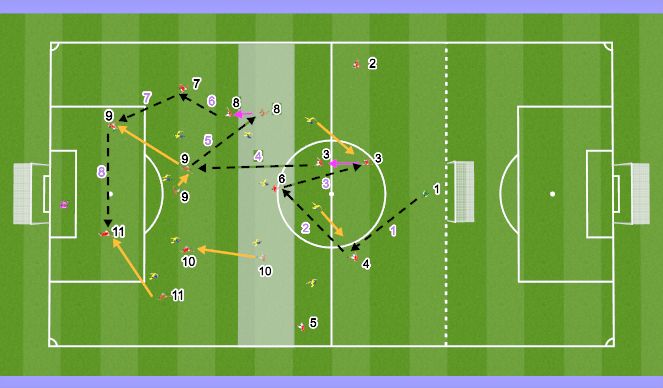
See the guidance at the top of this page to understand why you are not seeing interactive Football/Soccer images.

Training Game (15 mins)
Objective: We practise passing combinations with a focus on direct passes from the defenders to the forwards.
Organisation: We now use 2/3 of a full pitch and two teams play an 11v11 game.
Set Up: There is a 4v3 situation in the low zone, a 3v3 inside the middle zone and a 4v3 inside the high zone. The red defenders inside the low zone aim to pass the ball directly to the forwards inside the high zone so the team can move to the third stage of the attacking phase quickly. The three midfielders inside the middle zone shaded area help the defenders find the passing lanes towards the forwards but I cannot pass the ball forward to themselves. As soon as the forwards receive the ball, there are no restrictions in moving from area to area. The restrictions are also removed when the yellow players win the ball. The forwards are limited to one touch when receiving the vertical passes. The midfielders are also limited to one touch when helping their defenders find a passing lane.
Coaching Points: a. The defenders need to display good vision, awareness and timing to find the right pass through the midfield line available passing options. b. The forward should cheque away from their marker before moving to receive the ball.








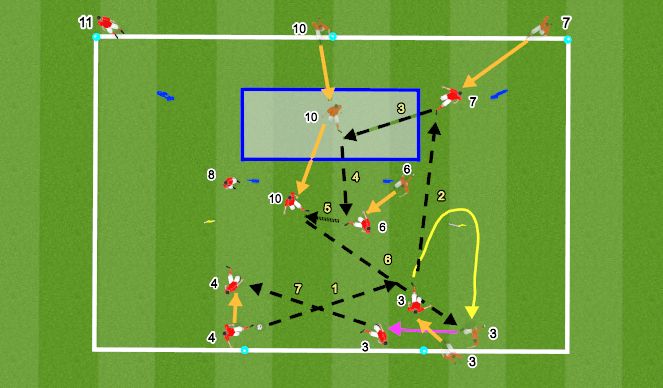
 Play animation
Play animation Play step-by-step
Play step-by-step Repeat (toggle)
Repeat (toggle) Full Screen
Full Screen Pause
Pause Stop
Stop
Passing Practice No.1 (15 mins)
Objective: We practise passing combinations with a focus on direct passes from the defenders to the forwards.
Organisation: We use an area 30 x 30 and have four mannequins, two poles, a marked-out rectangle area and a blue cone.
Set Up: Player no.4 passes to player no.3, who receives the ball and dribbles forward. As soon as he receives both player no.7 and player no.6 move to provide potential passing options. Player no.3 passes forwards to player no.7 and moves to provide a passing option for a potential pass back. At the same time, player no.10 drops back inside the target area behind the two mannequins which replicate the positions of opposition midfield players, receives and combines with player no.6. The final pass is back to player no.3 who has run round the pole into his starting position. Player no.3 receives and passes towards player no.4 and the exercise starts again towards the left side.
Coaching Points: a. The defenders should move forward quickly with the ball. b. The accuracy, weight and timing of the passes should be monitored. c. Players time their movements to receive and use the correct body shape to provide the appropriate passing options.